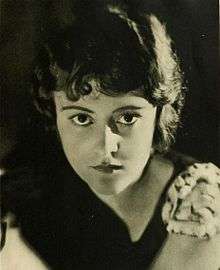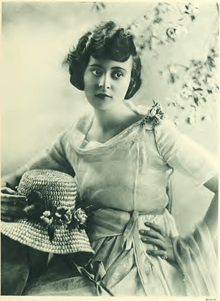Sylvia Breamer
| Sylvia Breamer | |
|---|---|
 | |
| Born |
9 June 1897 Sydney, Australia |
| Died |
7 June 1943 (aged 45) New York City, United States |
| Occupation | Actress |
Sylvia Breamer (9 June 1897 – 7 June 1943) was an Australian-born actress who performed in American silent motion pictures beginning in 1917.
Childhood and early career in Australia
She was born Sylvia Poppy Bremer [1][2] in the Sydney suburb of Double Bay, to Frederick Glasse Bremer and Jessie née Platt.[3] From a young age she trained for the stage with Walter Bentley and later at a Sydney Dramatic school run by Douglas Ancelon and Stella Chapman. She started to appear at recitations and on stage from the age of 13, soon after in productions for J. C. Williamson throughout Australia and New Zealand.[4] By 1915 she had come to the notice of reviewers, particularly after she stood in for Muriel Starr in a lead role in the Sydney run of George Broadhurst's play, Bought and Paid for.[5] By this time she was also famous enough to appear in newspaper advertisements for "Clement's Tonic." In 1914 Breamer married 40 year old E.W. Morrison, a US actor-director who regularly worked for J.C.Williamson. Like her Australian contemporary Enid Bennett, she determined to try her luck in the United States, and the couple departed for San Francisco in October 1916. The marriage appears to have been short lived however and Morrison returned to Australia in February 1917 without her.
Silent screen actress

Within a few months of arriving in the US, Breamer had appeared on stage in Boston and been tested by Thomas H. Ince.[6][7]
Her first movie for Ince was The Pinch Hitter, released in April 1917, where she took the leading female role next to Charles Ray. In 1918, she changed the spelling of her surname to Breamer, apparently to sound less German.[8] After Ince left the Triangle Film Corporation, she made numerous films for a variety of producers, including Ince and J. Stuart Blackton and opposite leading men including William S. Hart, Will Rogers, John Gilbert, Frank Mayo and Wallace Beery. Her film output was significant - she had appeared in forty films by 1924 and was an established and bankable star. In 1917 Ince had "predicted a future for Sylvia Breamer equally brilliant to that of his first Australian acquisition, Enid Bennett; and the initial assessment was, as the Lone Hand put it, that she "surpassed Bennett as actress by a long way."[4] On 1 November 1924 Breamer married Dr. Harry Martin at the Glenwood Inn in Riverside, California, announcing she would be retiring from films. Their divorce in 1926 was acrimonious and public, with Martin accusing her of cruelty.[9]Martin later went on to a long marriage to Louella Parsons. Breamer's final leading role in a film was in Lightning Reporter, in 1926, opposite Johnnie Walker.
She had one role in a talkie, a supporting part in the 1936 Frances Farmer, Lester Matthews vehicle Too Many Parents.
Later life
Breamer was reported as active in theatre in the early 1930s, when she also publicly criticized Hollywood. She reportedly said she "now loathes pictures and everything Hollywood means. There can be no real friendship in Hollywood - nothing but jealousy and sham."[10] Her sister Dora joined her in the United States in the 1920s, marrying actor William J.Kelly in 1925. Breamer's mother also moved to the US in the early 1920s.
In 1931, Breamer's engagement to actor Douglas Wood was announced, but it appears the marriage did not eventuate. In 1940, she was again in the news following a dispute over money after a divorce from aspiring politician Edmund R. Bohan.[11]
She died in New York City in 1943.
Partial filmography
- The Cold Deck (1917)
- The Narrow Trail (1917)
- We Can't Have Everything (1918)
- The Temple of Dusk (1918)
- A House Divided (1919)
- The Common Cause (1919)
- My Lady's Garter (1919)
- The Blood Barrier (1920)
- My Husband's Other Wife (1920)
- Bavu (1923)
- The Girl of the Golden West (1923)
- Flaming Youth (1923)
- Lilies of the Field (1924)
- The Woman on the Jury (1924)
- Up in Mabel's Room (1926)
References
- ↑ Sydney Morning Herald, 12 June 1897 Accessed 6/12/2015
- ↑ Los Angeles Times 21 Feb 1940, page A3 "Former Actress fights for Cash"
- ↑ In later years she was to claim her father was Captain of HMS Powerful, flagship of the Royal Navy's Australian Squadron, and her uncle the commander of the British cruiser HMS Queen Mary. See Photoplay, 1 Sep 1918 - 31 Dec 1918, Chicago, Photoplay Magazine Publishing. "The Daughter of the Powerful" by Julian Johnson. Neither claim appears compatible with the historical record. It appears likely she was a great grand-daughter of Admiral Sir James John Gordon Bremer rather than a daughter, as was often claimed by the contemporary US press. See for example The Los Angeles Times, November 2, 1924, P.7, "Sylvia Breamer is married." Accessed 14/12/2015
- 1 2 Desley Deacon, 2013. Australasian Journal of Victorian Studies."From Victorian Accomplishment to Modern Profession: Elocution Takes Judith Anderson, Sylvia Bremer and Dorothy Cumming to Hollywood, 1912-1918." National Library of Australia. Vol 18, No.1 Accessed 13/12/2015
- ↑ Sunday Times (Sydney, NSW : 1895 - 1930) 21 March 1915 Accessed 11/12/2015
- ↑ The Mirror of Australia (Sydney, NSW : 1915 - 1917) 17 March 1917 Accessed 11/12/2015
- ↑ Sydney Mail (NSW : 1912 - 1938) "Behind the Silver Sheet" by Kathleen Ussher, P.13, 27 June 1923 Accessed 8/1/2016
- ↑ Punch (Melbourne, Vic.: 1900 - 1918), 18 July 1918 Accessed 10/12/015
- ↑ The Los Angeles Times "Physician seeks divorce." April 20, 1926. Page A10. Accessed 13/12/2015
- ↑ Sunday Times (Perth, WA : 1902 - 1954) 14 December 1930, Page 11, "Miss Sylvia Breamer Outspoken" Accessed 9/1/2016
- ↑ The Los Angeles Times."Sylvia Breamer loses suit." March 15, 1940. Page A.1. Accessed 13/12/2015
| Wikimedia Commons has media related to Sylvia Breamer. |